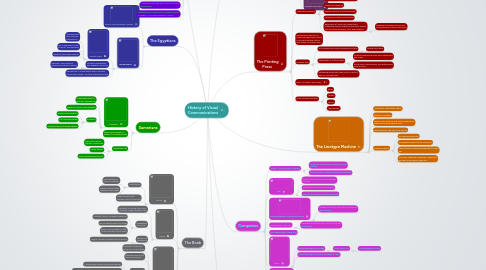
1. The Egyptians
1.1. Tombs, Great pyramids, temples
1.2. Hieroglyphics
1.2.1. Rosetta Stone
1.2.1.1. Deciphered by Jean Francois Champollion
1.2.1.2. has 3 languages: Greek, Demotic, Heiroglyphics
1.2.1.3. resides in the British Museum
1.2.2. contained logographic and alphabetic elements
1.2.2.1. logogram: visual symbols representing ideas or objects
1.2.3. derived from 2 Greek words "hiero" meaning sacred and "glyphic" meaning engraving/writing
2. Sumerians
2.1. Cuneiform
2.1.1. to help keep track of business transactions
2.1.2. began as a series of pictographs
2.1.3. Evolution
2.1.3.1. became more abstract
2.1.3.2. # of characters grew
2.1.3.3. characters became wedge shaped
2.2. chose sumer region to settle b/c of fertile ground
2.3. Things we know
2.3.1. Theocratic culture ruled by a priest king
2.3.2. skilled artisans
2.3.3. music=important part of life
3. The Book
3.1. Scrolls
3.1.1. Construction
3.1.1.1. long continuous pieces of papyrus
3.1.1.2. separate sheets glued together at the edges
3.1.2. simply rolled or had wooden rollers at each end
3.2. Codex
3.2.1. Definition:a covered and bound collection of hand written pages
3.2.2. Advantages over scroll
3.2.2.1. compact,sturdy, and ease if reference
3.2.2.2. can be opened flat to any page
3.2.2.3. easier use in libraries b/c title could be written on the spine
3.2.3. adopted by Christianity
3.2.3.1. used in churches for Bibles and scriptures
3.3. Parchment
3.3.1. Definition:a substrate made from animal skins
3.3.2. replaced papyrus b/c was more durable
3.3.3. How to make it
3.3.3.1. 1. remove hair and fat and smooth the skin
3.3.3.2. 2. soak hide in water solution; calcium, flour, salt added
3.3.3.3. 3. hide stretched out, flattened, and dried
3.4. Illuminated Manuscripts
3.4.1. word "illumination" refers to the borders, illustrations, and ornamentation added to each page of text
3.4.2. reserved for religious texts b/c were so laborious
3.4.3. creation of illuminated manuscripts declined b/c of printing press
4. Photography
4.1. Camera Obscura
4.2. Joseph Niepce created 1st successful photograph
4.3. Daguerreotype
4.3.1. created by Louis Daguerre
4.3.2. image was exposed to a light-sensitive metal sheet
4.4. Calotype Process
4.4.1. created by William Fox Talbot
4.4.2. image was exposed onto a light sensitive paper producing a paper negative
4.5. Wet Plate Process
4.5.1. created by Archer
4.5.2. glass plates were used for the negative to capture the image when exposed to light
4.6. Dry Plate Process
4.6.1. created by Richard Maddox
4.6.2. glass plates coated in gelatin
4.6.2.1. gelatin: a colorless water-soluble glutinous protein obtained from animal tissue
4.7. Kodak
4.7.1. established by Eastman
4.8. James Clerk Maxwell took 1st color photograph
4.9. Muybridge paved the way for motion picture photography
4.10. zoopraxiscope: a device used to project a series of images in successive phases of motion
5. Cave Paintings 55,000 years ago
5.1. common themes: large animals, tracings of human hands, abstract patterns
5.2. first form of visual communication
5.3. cave painting sites
5.3.1. Lascaux
5.3.1.1. closed b/c paintings were being damaged by carbon dioxide emitted from tourists
5.3.1.1.1. created the Lascaux II
5.3.1.2. most famous cave painting site
5.3.1.3. located in France
5.3.2. Almira cave
5.3.2.1. has a red hue b/c of red soil
5.3.2.2. located in Spain
5.3.2.3. discovered by Marcelino
5.3.3. Chauvet Pont d’Arc
5.3.3.1. painting techniques different b/c 3D effect was created
6. Phonetic Alphabet
6.1. theories of origin
6.1.1. direct variation of heiroglyphics
6.1.2. hypothesized ties with Cuneiform
6.2. one sign represents one spoken sounds
6.3. Effects
6.3.1. used in many different languages due to simplicity
6.3.2. disintegrated class divisions between royalty and the common man
6.3.3. Greek language adopted Phonetician letter forms
6.4. parts of the letters
6.4.1. Serif
6.4.1.1. finishing off strokes
6.4.2. Baseline
6.4.2.1. the line upon letters sit
6.4.2.2. ensured the type was perfectly aligned in rows
6.4.3. Descender
6.4.3.1. part of letter that goes under the baseline
6.5. was very simple
7. The Printing Press
7.1. Johannes Gutenberg
7.1.1. motivation: love of books & spending time with father at the mint watching goldsmiths and jewelers
7.1.2. created oil-based ink
7.1.3. experimented w/ metal topography
7.1.4. introduced modern book printing
7.1.5. agreement w/ John Fust stated that if Gutenberg couldn't repay the loan after 5 years, Fust could get the press, tools, and materials
7.1.5.1. agreement violated and Fust and Schoeffer took credit for the press
7.2. hand press in which ink is rolled over the raised surface of movable handset letters held within a wooden frame
7.3. Movable Type
7.3.1. 1st movable type system developed in China
7.3.1.1. carved from wood
7.3.2. Advantages of metal or wood
7.3.2.1. could be produced quicker once single mold was made
7.3.2.2. was quicker, more durable, and lettering was more uniform
7.3.3. Gutenberg made metal type out of an alloy of lead, tin, and antimony
7.4. Bible: 1st book to be printed
7.5. Major Printing Processes
7.5.1. Relief
7.5.2. Intalgio
7.5.3. Porous
7.5.4. Lithoography
8. The Linotype Machine
8.1. invented by Christopher Sholes
8.2. tested by Clephane
8.3. name comes from the fact that it produces an entire line of metal type at once
8.4. first installed in The New York Tribune
8.5. Keyboard Layout
8.5.1. 90 character keyboard
8.5.2. arrangment based on letter frequency
8.5.3. upper/lowercase keys were separate (no shift key
8.5.4. Black key: lowercase; White key: uppercase; Blue key: punctuation, digits, etc.
9. Computers
9.1. Univac= 1st commercial computer
9.1.1. created by John Preseper Eckert and John Mauchly
9.1.2. letters stand for Universal Automatic Computer
9.2. IBM
9.2.1. letters stand for International Business Machine
9.2.2. developed IBM701 EOPM Computer
9.2.3. developed first memory disk(floppy disk)
9.3. Douglas Engelbart invented the mouse
9.3.1. named mouse b/c of the "tail" connected to the computer
9.4. first internet= ARPANET
9.4.1. developed to protect flow of info b/w military installations
9.5. first memory disk= floppy disk
9.6. Apple
9.6.1. introduced Apple Lisa in 1983
9.6.1.1. 1st PC with a GUI
9.6.1.1.1. GUI developed by Xerox
9.6.2. introduced Apple Macintosh Computer in 1984
9.7. Microsoft
9.7.1. introduced MS-DOS
9.7.1.1. a computer operating system
9.7.2. introduced Windows in response to Apple's operating system
